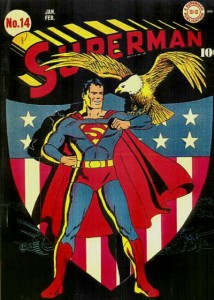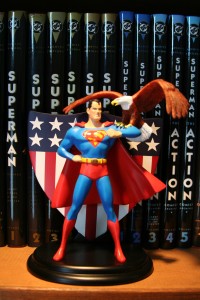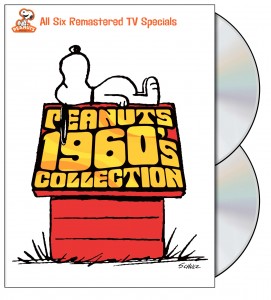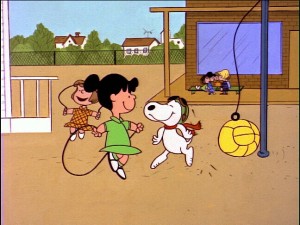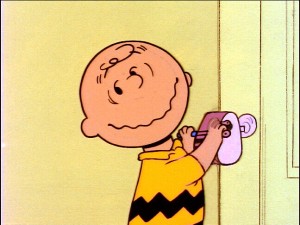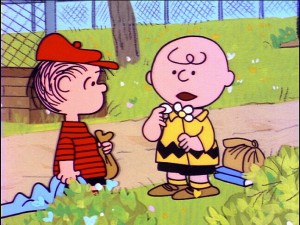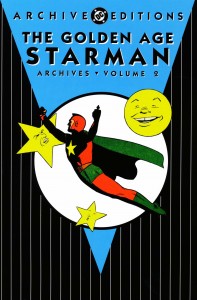With all of the attention being paid to Captain America (Steve Rogers) being “Reborn” on July 1st (just in time for the Independence Day Holiday on July 4th), I went back and read some of the early Golden Age adventures by Simon and Kirby. Unlike Batman who had a slow evolution as a character in the pages of Detective Comics during his first year, after the first issue of Captain America Comics (March 1941), the character and his sidekick, Bucky Barnes underwent very few changes. This is probably due to the fact that Captain America was a late entry into the realm of superheroes in the Golden Age. Superman had already been on the scene for three years and was soaring in popularity. Batman and Robin had been fighting crime together for almost two years. Timely’s own superhero stars, The Human Torch and The Sub-Mariner had also been around for a couple of years at this point.
Timely(Marvel) probably saw in Captain America the opportunity to capitalize on the growing patriotism in the U.S. with the looming and inevitable entry into WWII (thus, Cap punching Hitler on the cover of the first issue). Whatever the motive, Timely found an immediate hit with Captain America and Bucky. While there was no lack of patriotic heroes in 1941, Simon & Kirby hit the right formula for success with this feature. First, they appealed to America’s patriotic fervor by taking a frail young “everyman” and turning him into a super-soldier, who, dressed in the colors of our country, would strike at the heart of the evil represented by the Nazi movement. What young man in America in 1941 wouldn’t have wanted to be Steve Rogers? Second, they appealed to America’s young boys who wanted to join this cause, by giving Cap an able young sidekick, Bucky Barnes, to share in this life and death struggle for freedom and liberty. Third, Simon and Kirby simply knew how to tell a great adventure story through their writing and innovative art. The early Captain America stories are just fun to read.

Captain America #1 (March 1941)
As is the case with any Golden Age comic book, some of the Captain America stories are better than others. Following is my pick for the best Captain America and Bucky stories that appeared during the first six issues of the title. When considering this list, note that Captain America Comics was published monthly and contained three (sometimes four) stories in each issue. So, by the end of the first six months of this title, Timely had published 21 Captain America and Bucky stories.

Captain America is Born!
Right off of the bat, one of the best Captain America stories is the telling of his origin in Captain America Comics#1 (March 1941). Every time I read this story, I chuckle as F.D.R. says to his generals while discussing how to solve the problem of the dreaded Fifth Column, “What would you suggest gentlemen? A character out of the comic books? Perhaps the Human Torch in the army would solve our problem!” No, instead, Arthur Grover, head of the FBI takes the the generals to witness the injection of “frail” Steve Rogers with Professor Reinstein’s secret formula (he never wrote it down) to create “The first of a corps of super-agents whose mental and physical ability will make them a terror to spies and saboteurs!” Although the experiment was a success with Rogers, unfortunately, a Fifth Column spy had infiltrated the proceedings and shoots and kills Reinstein. He is quickly dispatched by Rogers, who is destined to be the only “super-agent” to fight for freedom and liberty. The story then fast forwards through a series of headlines showing how this new hero, Captain America has “become a powerful force in the battle against spies and saboteurs!” The story concludes with Rogers being stationed at Camp Lehigh where he meets the camp mascot, Bucky Barnes. Barnes later accidentally discovers Rogers’ secret identity and becomes Cap’s partner and sidekick. The story concludes, “And…so Bucky’s dream is fulfilled as he fights side by side with Captain America against the vicious elements who seek to overthrow the U.S. government!” We have also learned in this story that even Rogers’ commanding officers at the Camp do not know of his dual identity, and he has to often sneak away to perform his service to his country as Captain American. We will later learn that this often places him at odds with various military personnel. I’ve often wondered why the top military brass would station him in such a way as to put him at risk every time he ventures out as Captain America, but I guess that was part of the fun.

Meet Captain America – With Original Mask and Shield
Also in the first story, we get to see Captain America’s trademark uniform and shield. These were different in the first issue than in the rest of the Golden Age run. The shield is not the familiar round red, white and blue shield that we now associate with the character, but is instead a triangle. The only other difference was the mask, which only covered the head and upper face and did not extend down around his neck. Both would remain this way for the entirety of the first issue, and not be changed until issue #2 (April 1941).

First Appearance of The Red Skull
The first issue contains another of the best of Cap and Bucky’s early adventures with, “Captain America and the Riddle of the Red Skull”, the final story in the issue. With this story, we are introduced to Captain America’s chief nemesis, and one of the most evil super villains of all time. The Red Skull is a vile looking villain, complete with his namesake red skull face with glowing yellow eyes. He wears a green jumpsuit with a bright yellow swastika on the chest. After the Skull goes on a murderous rampage apparently scaring his victims to death after they look into his eyes, Captain America and Bucky track him down. After a battle in which the skull mask is broken, they discover that he is really Maxon, the owner of the Maxon Aircraft Company. They also learn that Maxon had actually injected poison into his victims and did not really scare them to death. After a struggle with Bucky, Maxon accidentally injects himself with his own poison and the Red Skull dies. Or does he?

Captain America #2 (April 1941)
In Captain America Comics#2 (April 1941) Cap and Bucky have another of their early great adventures in “Trapped in the Nazi Stronghold”. After wealthy financier Henry Baldwin has promised his vast fortune to aid Britain in fighting Hitler’s forces, he is kidnapped by spies and taken to Germany. Captain America and Bucky decide to travel to Europe to try to save Baldwin (Cap dressed as an old woman and Bucky as her grandson). While on the plane (a “large clipper”) they discover Baldwin being held by thugs, but despite their heroic efforts to save him he again vanishes. We finally learn that Baldwin has been taken to Hitler himself where he is being held while a Baldwin impostor will take his place and commit his fortune to the Nazis. Cap and Bucky ultimately unmask the impostor and discover where the real Baldwin is being held. Our heroes then travel into “the Nazi stronghold” to rescue Baldwin from execution and come face to face with Hitler and Goering. After a wild battle involving tanks, planes, guns and many soldiers, Cap and Bucky personally defeat Hitler and Goering and rescue Baldwin. This story is well done, has a lot of action, and features Captain America’s first face to face encounter with Hitler.

Cap and Bucky Meet Hitler and Goering
The cover to Captain America Comics#3 (May 1941) sets the stage for another of Caps best early adventures. On this cover, we learn that “The Red Skull planned a horrible death for Bucky and Betty – unless…” That’s right, The Skull is back! By the way, Betty Ross, featured on this cover, is a recurring Golden Age Captain America character, having first appeared in the first issue. In this story, we learn that the Red Skull is back with more plans of murder and terror on United States soil. In fact, the Skull has created a huge underground “Power Drill” machine that he drives underground like a giant mole. He uses the machine to destroy buildings and other infrastructure on the surface. Despite several attempts to stop him, Cap and Bucky can’t find a way to destroy this machine or capture the Skull. As a side story, we also meet a couple of two-bit thugs who dress as Cap and Bucky in order to defraud people to pay an admission to meet the “real” heroes. Unfortunately for these thugs, the Skull captures them thinking they are the real Captain America and Bucky and hangs them from gallows in his underground lair. Arriving too late to save the impostors from their fate, Cap and Bucky had tracked the Skull underground and an epic battle ensues. The battle concludes with the Skull, sitting atop his mole machine, throwing a bomb at our heroes. Cap catches the bomb and throws it back at the Skull an instant before it explodes, blasting the machine to bits and presumably again killing the Red Skull. But will he be back?

Captain America #3 (May 1941)
Another notable event takes place in Captain America Comics#3. While not one of my favorite stories, “The Queer Case of the Murdering Butterfly and the Ancient Mummies” features a first for Captain America. Until this episode, Cap had always used his famous shield to block bullets or other objects, as a battering ram or to knock thugs unconscious. In this story, for the first time Cap launches his shield through the air to knock his adversary out of the sky. The shield as a flying weapon was not used often in the early Golden Age episodes, but it became a trademark of Captain America in later years.

Cap throws his shield for the first time
In Captain America Comics#4 (June 1941), Captain America and Bucky are placed in a very unique setting in “Captain America and Ivan the Terrible”. In this story, we learn that Betty Ross has been taken prisoner by Ivan the Terrible. It seems that Ivan has taken the throne from the rightful king, Betty’s father. After Ivan has Betty thrown into the dungeon where “her beauty may rot forever”, we learn that he has also captured Captain American and Bucky. After Cap and Bucky are also thrown into the dungeon next to Betty, they break out (Cap bends the steel bars with his bare hands), defeat the guards and returns Betty to her father, King Peter Ross. After Cap and Bucky vow to help King Peter regain his throne, they return to the castle where Cap convincingly defeats Ivan in hand to hand combat. Ivan agrees to “resign” the throne in favor of King Peter, and the story concludes with a rare full-page panel drawing of Cap and Bucky being carried on the shoulders of the King’s subjects while the King triumphantly returns to his castle, Betty at his side, on horseback. As you might imagine, the last page of the story reveals that this was all Bucky’s dream, but a grand adventure nevertheless!

Captain America #4 (June 1941)

One of the first full page panels in the Golden Age of Comics
The cover to Captain America Comics#5 (July 1941) features another great early adventure. In “Captain America and the Ringmaster of Death” we meet the evil “Ringmaster of Crime” who uses his “wheel of death” to determine who his next victim will be. After the Ringmaster kills General Blaine and Defense Commissioner Newsome by using the members of his evil circus, he captures Betty Ross. Cap and Bucky determine that Betty has been taken to the evil circus and make their way there to rescue Betty. After several fierce battles with elephants, an ape-man and a giant strong man, Cap and Bucky execute a daring acrobatic trapeze rescue of Betty who has been dropped from the top of the circus tent to a sure death. Cap then pursues the Ringmaster into his tent and captures him for the authorities. This story is a lot of fun.

Captain America #5 (July 1941)
By the way, the Red Skull did return in Captain America Comics #7 (September 1941) and later in a classic story in Captain America Comics #16 (July 1942), reprinted recently in Captain America #600.

Captain America #16 (July 1942)
If you want to read any of these early Golden Age Captain America stories, Marvel has reprinted them all in the first two volumes of its Golden Age Captain America Marvel Masterworks. Although a late comer to the Golden Age, Captain America became one of the most popular superheroes during this era. I’m pleased that Marvel has decided to bring back Steve Rogers in this role in their “Reborn” series later this week.
I covered the Golden Age history of Captain America and Bucky way back in the Golden Age of Comic Books Podcast #10 in 2005.
Like this:
Like Loading...

